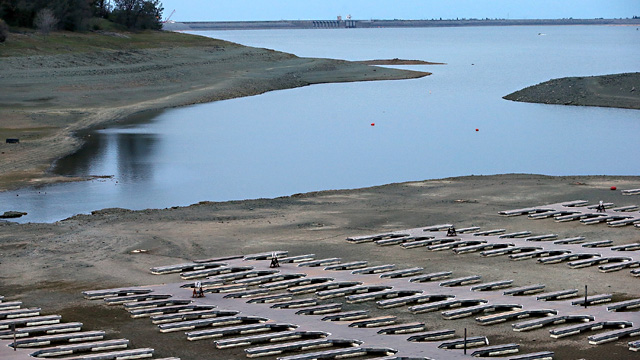MILLER: So this is framing the drought as farms versus fish. It’s an old drumbeat and it’s one that I think a lot of observers would say is a bit simplistic, given California’s complex water picture.
SHAFER: A very much less predictable or anticipated impact of the drought this week played out with state School Superintendent Tom Torlakson touring the Central Valley and some of the school districts there. Describe what he was there to talk about.
MILLER: Yeah. So this is an example of the unpredictable, I think. Who would’ve thought, I mean obviously if you’re close to the situation you see it happening, but who would’ve thought that the drought would have such a direct impact on public schools of all things? But as hundreds of thousands of acres go fallow, which will be happening this year -- that means acreage not put into production -- farmworker families will leave the towns where they’ve been.
SHAFER: And maybe leave California.
MILLER: And maybe leave California altogether for greener pastures, so to speak. Baldomero Hernandez, he’s certainly given it a lot of thought. He’s superintendent of the Westside Elementary School District down there. Here’s how he frames it:
HERNANDEZ: Within a year or two my school district will be closed. Bottom line. With a zero allocation of water, that means next year 80 percent of the workforce out there in my area is laid off. It’s gone. They’re gonna leave.
MILLER: And when they leave, that impacts the school districts directly because their state funding is tied directly to attendance.
SHAFER: And so what can the state, what will the state do about it?
MILLER: Well, they’re working on a plan right now that would allow school districts to maintain their funding at a certain level for a limited period of time even if students leave. But it’s just a temporary fix.
SHAFER: And Craig, something else happened this week, also unexpected and much more bipartisan and more maybe solution-oriented, you might say. Two members of Congress in California, one Democrat John Garamendi and a Republican, Doug LaMalfa from Redding, stood up to say that they both supported a major water project here in California: a large reservoir. What’s that about?
MILLER: So that’s about seizing the moment. You know, you’ve been covering politics for a long time so you’re familiar with the time-worn adage …
SHAFER: “Let no crisis go unused or taken advantage of…”
MILLER: …or should go to waste.” Right. So this is the drought as an opportunity to revive some ideas that have been on the table, some of them for years or even decades. And so Garamendi is introducing a bill that would authorize construction of this enormous off-stream reservoir off the Sacramento River, I guess I should say, not on the Sacramento River. But if you go about halfway from Sacramento to Redding and turn left, there’s a remote valley over there which is home currently to a few ranches and a tiny little wide spot on the road called Sites S-I-T-E-S, which they’re thinking about walling off basically so they could pump water out of the Sacramento River when we have, say, a wet winter, filling up that valley, and then pump it back into the river when we need it. So, it’s kind of like if the river is a freeway, this is kind of like the rest area they want to create.
SHAFER: Well, isn’t that really out of favor with environmentalists and by extension Democrats?
MILLER: One of the reasons they like this particular project is because it is “off-stream.” In other words, there’s no need to dam a current waterway, which has huge environmental implications. It may be safe to say that that will never happen again in California, so this like one of the few alternatives that may be workable. But it’s hugely expensive.
SHAFER: How expensive?
MILLER: Well, an estimate back in 2007, that’s how long they’ve been studying this, actually longer, was that it would come in at about $3 billion, and there’s no funding in the bill.
SHAFER: And so where are they suggesting the funding would come from?
MILLER: Possibly partly federal money and possibly partly the ultimate beneficiaries of the water would help pay for it.
SHAFER: But a bipartisan idea nonetheless, which is progress. Craig, we did get a fair amount of rain in February, so where do we stand as April approaches here?
MILLER: In a deep dry hole, Scott. In January, NOAA, the federal climate guys, declared much of California to be in “exceptional drought.” This is the worst drought condition that they have on their scale and it’s the first time in the history of the 15-year drought-monitor tracking index that they’ve done, that’s the first time that they’ve ever put California in that. About a quarter of the state in is that category right now, and about 90 percent of the state is in at least “severe drought” or worse.
SHAFER: So the time for denial or hope for a miraculous deluge is pretty much over.
MILLER: It’s over, that’s right. We’re looking at a long dry summer ahead.
SHAFER: All right. KQED’s Science Editor Craig Miller. Craig, thanks a lot.
More: Drought Impacts Central Valley School Enrollment While Debate Over Relief Continues
